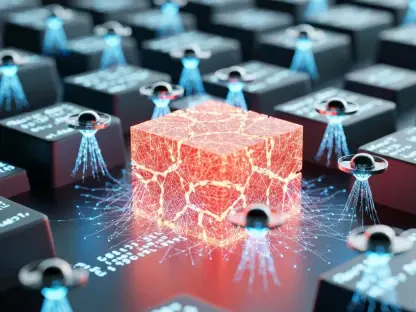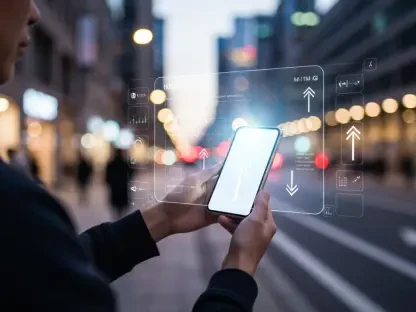In a world increasingly shaped by artificial intelligence, the release of ChatGPT 5 in August of this year stands as a monumental milestone that promises to redefine human interaction with technology. This latest innovation from OpenAI isn’t merely an incremental update but a bold leap forward, blending unparalleled reasoning abilities with conversational depth that feels strikingly human. As industries and individuals alike grapple with the rapid pace of digital transformation, ChatGPT 5 emerges as a tool that could fundamentally alter how tasks are approached, from complex problem-solving to everyday communication. The buzz surrounding this launch is palpable, with experts and users eager to explore what this model brings to the table. This article dives deep into the groundbreaking features of ChatGPT 5, its accessibility to a wide audience, the historical context of OpenAI’s AI evolution, and the transformative potential it holds across various sectors. By unpacking these elements, a clearer picture emerges of why this release is generating such excitement and how it might shape the technological landscape in the years ahead, starting from this pivotal moment in 2025 through to future horizons.
Revolutionary Advancements in AI Technology
The arrival of ChatGPT 5 marks a seismic shift in the capabilities of conversational AI, setting a new standard for what these systems can achieve. Described by OpenAI’s CEO, Sam Altman, as an “instant PhD-level expert” across a vast array of subjects, this model integrates traditional language processing with sophisticated reasoning skills. Unlike its predecessors, it excels in tackling intricate queries with precision, offering responses that are not only accurate but also contextually nuanced. Faster response times ensure that interactions feel fluid and natural, mimicking real-time conversation with a knowledgeable partner. Additionally, enhancements in internet browsing capabilities allow it to pull in relevant, up-to-date information, while improved visual processing broadens the scope of how users can engage with the system. These technological strides position ChatGPT 5 as a frontrunner in pushing the boundaries of artificial intelligence, hinting at a future where such tools could become indispensable across diverse applications.
Beyond the headline-grabbing features, ChatGPT 5 introduces a deeper level of contextual understanding that transforms multi-turn conversations into seamless exchanges. Where earlier models might lose track of context over extended dialogues, this iteration maintains coherence, remembering prior inputs and responding accordingly. This capability is particularly valuable for users engaged in complex tasks, such as drafting detailed reports or solving multi-step problems, where continuity is key. The model’s broader knowledge base also means it can address a wider range of topics with authority, reducing the likelihood of vague or off-target answers. By combining these advancements into a unified system, OpenAI has crafted a tool that not only answers questions but anticipates needs, paving the way for more intuitive human-AI collaboration. This leap forward underscores the potential of ChatGPT 5 to redefine productivity and creativity in ways previously unimaginable.
Broadening Access to Cutting-Edge Tools
One of the most commendable aspects of ChatGPT 5 is its commitment to inclusivity, ensuring that advanced AI technology is within reach for a global audience. Available to both free-tier users and subscribers of Plus, Pro, and Team plans, the model offers varying levels of access tailored to different needs. Free users can experience its core functionalities with standard usage limits, while paid subscribers benefit from expanded thresholds and priority access during peak times. This tiered approach strikes a balance between widespread availability and premium features, making sure that individuals, small businesses, and large enterprises alike can leverage its power. Importantly, integration into the existing ChatGPT platform means no additional downloads or complicated setups are required, simplifying the transition for users at all levels of technical expertise.
This democratization of AI technology aligns with OpenAI’s mission to foster innovation by breaking down barriers to access. By making ChatGPT 5 available to such a diverse user base, the organization ensures that everyone—from students exploring educational resources to developers building custom applications—can tap into its capabilities. This accessibility is not just about numbers but about impact, as it empowers communities worldwide to solve problems, enhance productivity, and drive creativity. For businesses, this means leveling the playing field, allowing smaller entities to compete with larger ones through AI-driven solutions. The ease of use and broad availability of ChatGPT 5 signal a shift toward a more inclusive technological ecosystem, where the benefits of cutting-edge tools are shared widely rather than confined to a select few.
Tracing the Path of AI Development
Understanding the significance of ChatGPT 5 requires a look back at the evolutionary journey of OpenAI’s language models, each building on the successes and lessons of its predecessors. The story began with GPT-3 in 2020, a model that stunned the world with its ability to generate human-like text across a vast array of topics. This was followed by the introduction of ChatGPT in 2022, fine-tuned specifically for conversational engagement, making interactions safer and more user-friendly. The release of GPT-4 in 2023 marked another leap, incorporating multimodal inputs like images alongside text and offering sharper reasoning skills. Subsequent updates, such as GPT-4 Turbo and ChatGPT-4o, focused on refining speed and responsiveness, addressing user demands for quicker, more efficient interactions. Each step in this progression has been marked by a commitment to improvement, driven by technological innovation and user feedback.
ChatGPT 5 stands as the culmination of this iterative process, directly addressing lingering challenges from earlier models, such as factual inaccuracies and limited access to real-time data. By integrating a more robust knowledge base and enhancing its ability to process and interpret diverse inputs, it overcomes many of the hurdles that once constrained AI conversations. This model reflects OpenAI’s strategy of learning from past limitations, ensuring that each release is not just an upgrade but a meaningful advancement. The journey from GPT-3 to ChatGPT 5 illustrates a relentless pursuit of excellence, positioning OpenAI as a leader in the AI field. As this latest model builds on a strong foundation, it also sets the stage for future developments, hinting at even more sophisticated tools from 2025 onward that could further blur the line between human and machine intelligence.
Anticipated Capabilities and Innovations
While some specifics about ChatGPT 5 remain under wraps, early insights and industry speculation paint an exciting picture of its potential capabilities. Enhanced reasoning stands out as a flagship feature, promising to handle complex, multi-layered problems with a depth that rivals expert analysis. Beyond text, the model is expected to push multimodal integration to new heights, possibly incorporating audio and video inputs alongside traditional text and images. This would enable richer, more dynamic interactions, such as interpreting spoken instructions or analyzing visual content in real time. Additionally, improvements in long-context understanding mean that ChatGPT 5 can maintain focus over extended conversations, making it a reliable partner for intricate discussions or projects that unfold over time.
Another anticipated advancement lies in the model’s ability to reduce factual errors, often referred to as “hallucinations” in AI terminology, ensuring more trustworthy outputs. Users may also find that less explicit prompting is needed, as ChatGPT 5 is slated to grasp implied requests with greater accuracy, streamlining interactions. There’s also buzz around potential customization options, which could allow individuals to tailor the AI’s responses to specific preferences or professional needs. These innovations suggest a shift toward a more intuitive and adaptable assistant, capable of meeting diverse user demands with minimal friction. As these features come into focus, they highlight ChatGPT 5’s role as a bridge to a future where AI becomes an even more seamless part of daily life, enhancing everything from personal tasks to large-scale operations.
Redefining Sectors and Personal Productivity
The impact of ChatGPT 5 is set to ripple across multiple domains, with business emerging as a primary beneficiary of its advanced capabilities. In corporate settings, the model offers sophisticated solutions for customer service, financial analysis, and workflow automation. Its potential integration with platforms like Microsoft products could transform enterprise applications, enabling AI agents to resolve complex customer queries in a single interaction, thus slashing wait times and boosting satisfaction. Beyond service, businesses can harness its reasoning skills for strategic decision-making, analyzing vast datasets to uncover insights that drive competitive advantage. This level of automation and intelligence promises to redefine operational efficiency, allowing companies of all sizes to optimize resources and focus on innovation.
In the realm of education, ChatGPT 5 holds the potential to revolutionize learning and research by providing personalized tutoring and deep analytical support. Students tackling challenging subjects can benefit from tailored explanations that adapt to their pace and style, making abstract concepts more accessible. Researchers, meanwhile, can leverage the model’s ability to sift through extensive academic literature or datasets, accelerating discoveries in fields like medicine or environmental science. For everyday users, the model serves as a productivity booster, enhancing tasks such as writing professional documents, debugging code, or brainstorming creative ideas. Its context-aware assistance ensures that responses remain relevant even across lengthy exchanges, mimicking a human-like memory that elevates usability. Across these varied applications, ChatGPT 5 emerges as a transformative force, reshaping how knowledge is accessed and applied in both professional and personal contexts.
Reflecting on a Milestone in AI Progress
Looking back, the launch of ChatGPT 5 in August of this year proved to be a defining moment in the trajectory of conversational AI, setting a benchmark for future innovations. Its blend of rapid responses, advanced reasoning, and multimodal capabilities established a new frontier for what digital assistants could accomplish. The commitment to accessibility, evident in its availability to free and paid users alike, mirrored OpenAI’s vision of an inclusive technological landscape where powerful tools were not reserved for a privileged few. Spanning industries from business to education, the model’s applications demonstrated a versatility that touched countless aspects of daily life. As technical and ethical challenges were acknowledged alongside these achievements, a balanced perspective emerged, emphasizing that progress must always be paired with responsibility. Moving forward, the focus should shift to building on this foundation, exploring ways to further refine AI’s accuracy and integration while ensuring robust safeguards against misuse. The legacy of this release lies in its invitation to imagine—and actively shape—a future where technology amplifies human potential in ever more meaningful ways.









